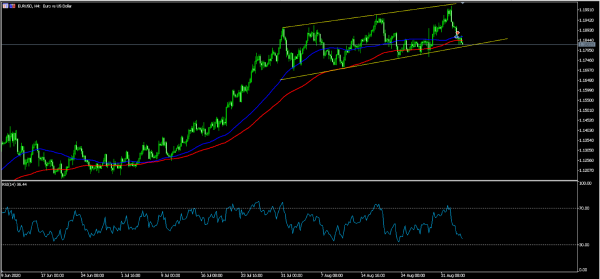The dollar strength continued in the Asian session as traders continued to bet on a V-shaped recovery after strong economic data from the United States. Yesterday, data from ADP showed that American firms added more than 428K jobs in August. While that number was below the expected 950k, it was higher than the previous month’s 212k. Other data from the US showed that car and truck sales rose to 3.56 million and 11.63 million, respectively. Meanwhile, factory orders rose by 6.4% in July. Later today, traders will react to the non-manufacturing PMI data from ISM and Markit. We will also receive the initial jobless claims and trade numbers.
The price of crude oil declined even after the EIA released better-than-expected inventories data. The numbers showed that inventories dropped by more than 9.36 million barrels in the previous week. That was better than the 1.8 million that analysts were expecting. It was also better than the previous week’s decline of 4.68 million barrels. On Tuesday, data from the American Petroleum Institute (API) showed that the inventories dropped by more than 2 million barrels. Importantly, the drawdown has been going on for the past six straight weeks.
The economic calendar will have important data from around the world. In Switzerland, the Federal Statistics Office will release the August inflation data. Analysts expect that consumer inflation fell by 0.8% in August. Other important data will be from Markit, which will release the services PMI data from most countries. According to Reuters, analysts expect that the services PMI in the Eurozone dropped from 54.7 to 50.0. Meanwhile, Eurostat will release the July retail sales data from the Eurozone. In Canada, the statistics office will release the July export and import data.
EUR/USD
The EUR/USD pair dropped sharply yesterday. It is now trading at 1.1825, which is significantly lower than the YTD high of 1.2013. On the four-hour chart, the price has just moved below the 50-day and 100-day exponential moving averages. The pair has also formed an equidistance channel that is shown in yellow below while the RSI has continued to drop. Therefore, the level to watch will be 1.1820, which is the lower side of the channel. A move below that line will send a signal that bears have prevailed, which is likely to push the pair lower.
XBR/USD
The XBR/USD pair dropped to an intraday low of 44.15. On the daily chart, the price is between the 50% and 38.2% Fibonacci retracement level. It is also slightly above the 50-day and 100-day exponential moving averages. The pair is also forming an ascending wedge pattern. Therefore, the pair is likely to break out lower in the near term, with the main support to watch being 40. On the flip side, the pair could also attempt to move higher to the next resistance level at 50.0.
AUD/USD
The AUD/USD pair dropped to an intraday low of 1.3324 on the four-hour chart as traders reacted to Australia’s trade and services PMI data. On the four-hour chart, the price is substantially lower than the YTD high of 1.3485. The price has also moved below the 25-day EMA while the signal line of the MACD has started to fall. Therefore, the pair is likely to continue falling as bears aim for the next support at 1.3200.
















